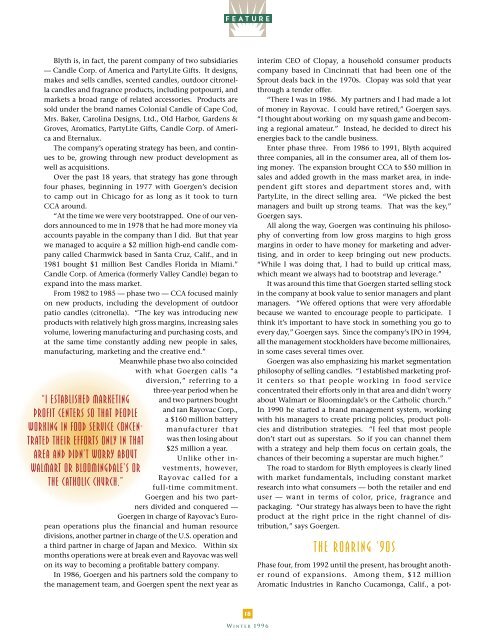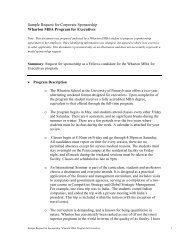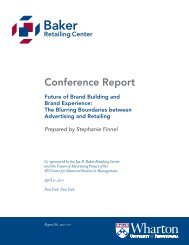wharton's prescription for health care - Wharton Magazine
wharton's prescription for health care - Wharton Magazine
wharton's prescription for health care - Wharton Magazine
Create successful ePaper yourself
Turn your PDF publications into a flip-book with our unique Google optimized e-Paper software.
FEATUREBlyth is, in fact, the parent company of two subsidiaries— Candle Corp. of America and PartyLite Gifts. It designs,makes and sells candles, scented candles, outdoor citronellacandles and fragrance products, including potpourri, andmarkets a broad range of related accessories. Products aresold under the brand names Colonial Candle of Cape Cod,Mrs. Baker, Carolina Designs, Ltd., Old Harbor, Gardens &Groves, Aromatics, PartyLite Gifts, Candle Corp. of Americaand Eternalux.The company’s operating strategy has been, and continuesto be, growing through new product development aswell as acquisitions.Over the past 18 years, that strategy has gone throughfour phases, beginning in 1977 with Goergen’s decisionto camp out in Chicago <strong>for</strong> as long as it took to turnCCA around.“At the time we were very bootstrapped. One of our vendorsannounced to me in 1978 that he had more money viaaccounts payable in the company than I did. But that yearwe managed to acquire a $2 million high-end candle companycalled Charmwick based in Santa Cruz, Calif., and in1981 bought $1 million Best Candles Florida in Miami.”Candle Corp. of America (<strong>for</strong>merly Valley Candle) began toexpand into the mass market.From 1982 to 1985 — phase two — CCA focused mainlyon new products, including the development of outdoorpatio candles (citronella). “The key was introducing newproducts with relatively high gross margins, increasing salesvolume, lowering manufacturing and purchasing costs, andat the same time constantly adding new people in sales,manufacturing, marketing and the creative end.”Meanwhile phase two also coincidedwith what Goergen calls “adiversion,” referring to athree-year period when he“I ESTABLISHED MARKETINGPROFIT CENTERS SO THAT PEOPLEWORKING IN FOOD SERVICE CONCEN-TRATED THEIR EFFORTS ONLY IN THATAREA AND DIDN’T WORRY ABOUTWALMART OR BLOOMINGDALE’S ORTHE CATHOLIC CHURCH.”and two partners boughtand ran Rayovac Corp.,a $160 million batterymanufacturer thatwas then losing about$25 million a year.Unlike other investments,however,Rayovac called <strong>for</strong> afull-time commitment.Goergen and his two partnersdivided and conquered —Goergen in charge of Rayovac’s Europeanoperations plus the financial and human resourcedivisions, another partner in charge of the U.S. operation anda third partner in charge of Japan and Mexico. Within sixmonths operations were at break even and Rayovac was wellon its way to becoming a profitable battery company.In 1986, Goergen and his partners sold the company tothe management team, and Goergen spent the next year asinterim CEO of Clopay, a household consumer productscompany based in Cincinnati that had been one of theSprout deals back in the 1970s. Clopay was sold that yearthrough a tender offer.“There I was in 1986. My partners and I had made a lotof money in Rayovac. I could have retired,” Goergen says.“I thought about working on my squash game and becominga regional amateur.” Instead, he decided to direct hisenergies back to the candle business.Enter phase three. From 1986 to 1991, Blyth acquiredthree companies, all in the consumer area, all of them losingmoney. The expansion brought CCA to $50 million insales and added growth in the mass market area, in independentgift stores and department stores and, withPartyLite, in the direct selling area. “We picked the bestmanagers and built up strong teams. That was the key,”Goergen says.All along the way, Goergen was continuing his philosophyof converting from low gross margins to high grossmargins in order to have money <strong>for</strong> marketing and advertising,and in order to keep bringing out new products.“While I was doing that, I had to build up critical mass,which meant we always had to bootstrap and leverage.”It was around this time that Goergen started selling stockin the company at book value to senior managers and plantmanagers. “We offered options that were very af<strong>for</strong>dablebecause we wanted to encourage people to participate. Ithink it’s important to have stock in something you go toevery day,” Goergen says. Since the company’s IPO in 1994,all the management stockholders have become millionaires,in some cases several times over.Goergen was also emphasizing his market segmentationphilosophy of selling candles. “I established marketing profitcenters so that people working in food serviceconcentrated their ef<strong>for</strong>ts only in that area and didn’t worryabout Walmart or Bloomingdale’s or the Catholic church.”In 1990 he started a brand management system, workingwith his managers to create pricing policies, product policiesand distribution strategies. “I feel that most peopledon’t start out as superstars. So if you can channel themwith a strategy and help them focus on certain goals, thechances of their becoming a superstar are much higher.”The road to stardom <strong>for</strong> Blyth employees is clearly linedwith market fundamentals, including constant marketresearch into what consumers — both the retailer and enduser — want in terms of color, price, fragrance andpackaging. “Our strategy has always been to have the rightproduct at the right price in the right channel of distribution,”says Goergen.THE ROARING ‘90SPhase four, from 1992 until the present, has brought anotherround of expansions. Among them, $12 millionAromatic Industries in Rancho Cucamonga, Calif., a pot-18W INTER 1996
















